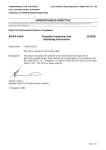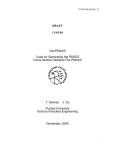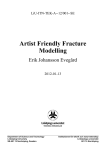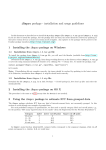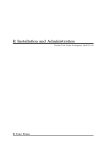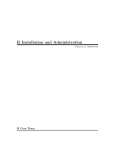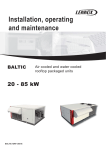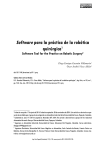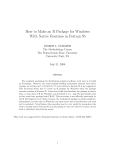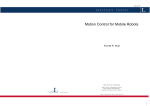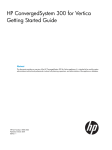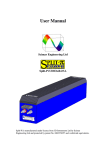Download How To Make an R Package Based on C++ And Manage It With R
Transcript
How To Make an R Package Based on C++ And Manage It With R-Forge: A Tutorial José M. Maisog Medical Numerics, Inc., and Georgetown University Medical Center [email protected] [email protected] http://howtomakeanrpackage.pbworks.com Version 1.14 January 11, 2011 Table of Contents List of Figures 3 1 Introduction 4 2 Software Setup 2.1 Software For Making R Packages Based on C++ . . 2.1.1 R (required) . . . . . . . . . . . . . . . . . . . 2.1.2 RTools (required) . . . . . . . . . . . . . . . . 2.1.3 MiKTeX (optional) . . . . . . . . . . . . . . . 2.1.4 Microsoft HTML Help Workshop (optional) 2.1.5 perl (optional) . . . . . . . . . . . . . . . . . . 2.1.6 Set Up Your Windows Path Variable . . . . 2.1.7 Dev-C++ or NotePad++ (optional) . . . . . 2.2 Software for Using R-Forge . . . . . . . . . . . . . . . 2.2.1 TortoiseSVN . . . . . . . . . . . . . . . . . . . 2.2.2 PuTTY . . . . . . . . . . . . . . . . . . . . . . 3 Example C++ Code: 3.1 RMat.h . . . . . . . 3.2 RMat.cc . . . . . . 3.3 testRMat.cc . . . . A . . . . . . . . . . . . . . . . . . . . . . . . . . . . . . . . . . . . . . . . . . . . . . . . . . . . . . . . . . . . . . . . . . . . . . . . . . . . . . . . . . . . . . . . . . . . . . . . . . . . . . . . . . . . . . . . . . . . . . . . . . . . . . . . . . . . . . . . . . . . . . . . . . . . . . . . . . . . . . . . . . . . . . . . . . . . . . . . . . . . . . 6 6 6 6 6 7 7 7 12 12 12 13 Simple Matrix Class 14 . . . . . . . . . . . . . . . . . . . . . . . . . . . . . . . . . . 15 . . . . . . . . . . . . . . . . . . . . . . . . . . . . . . . . . . 16 . . . . . . . . . . . . . . . . . . . . . . . . . . . . . . . . . . 20 4 Make a Shared (Dynamically Linked) Library 4.1 RInterface.cc . . . . . . . . . . . . . . . . . . . . . 4.2 Run RCMD SHLIB . . . . . . . . . . . . . . . . . 4.3 Load the DLL into R . . . . . . . . . . . . . . . . 4.4 Check that the DLL has been properly loaded . 4.5 MatrixMult.r . . . . . . . . . . . . . . . . . . . . . 4.6 Test the R Wrapper Function . . . . . . . . . . . 4.7 Unload the DLL . . . . . . . . . . . . . . . . . . . . . . . . . . . . . . . . . . . . . . . . . . . . . . . . . . . . . . . . . . . . . . . . . . . . . . . . . . . . . . . . . . . . . . . . . . . . . . . . . . . . . . . . . . . . . . . . . . . . . . . . . . . . . . . . . . . . . . . . . . . . . . . . . 22 22 24 25 25 26 27 28 5 Make An R Package 29 5.1 Create the R Package Folder Structure . . . . . . . . . . . . . . . . . . . . . . . . 29 5.2 Run RCMD CHECK . . . . . . . . . . . . . . . . . . . . . . . . . . . . . . . . . . 30 1 5.3 5.4 5.5 5.6 5.7 The DESCRIPTION and NAMESPACE files Add src folder for C++ Code . . . . . . . . . Fix the Documentation Files . . . . . . . . . . Run RCMD BUILD . . . . . . . . . . . . . . . Install/Uninstall Your R Package . . . . . . . . . . . . . . . . . . . . . . 6 R-Forge: Cross-Platform Builds and Submitting 6.1 Create Your R-Forge Account . . . . . . . . . . . . 6.2 Register Your Project . . . . . . . . . . . . . . . . . 6.3 Configure Your Security . . . . . . . . . . . . . . . . 6.4 Check Out Files from R-Forge . . . . . . . . . . . . 6.5 Modify Check Out Folder Contents . . . . . . . . . 6.6 Commit Modification To R-Forge . . . . . . . . . . 6.7 Submit R Package to CRAN . . . . . . . . . . . . . . . . . . . . . . . to . . . . . . . . . . . . . . . . . . . . . . . . . . . . . . . . . . . . . . . . . . . . CRAN . . . . . . . . . . . . . . . . . . . . . . . . . . . . . . . . . . . . . . . . . . . . . . . . . . . . . . . . . . . . . . . . . . . . . . . . . . . . . . . . . . . . . . . . . . . . . . . . . . . . . . . . . . . . . . . . . . . . . . . . . . . . . . . . . . . . . . . . . . . . . . . 30 31 31 33 33 . . . . . . . 35 36 36 36 36 47 47 49 Bibliography 55 A MinGW gcc: Link Stand-Alone Example C++ Code To R Libraries 56 B Dev-C++: Link Stand-Alone Example C++ Code To R Libraries 58 2 List of Figures 2.1 2.2 2.3 2.4 2.5 2.6 System Properties. . . . Environment Variables. Edit System Variables. Edit Path in WordPad. The Run Dialog Box. . DOS prompt. . . . . . . . . . . . . . . . . . . . . . . . . . . . . . . . . . . . . . . . . . . . . . . . . . . . . . . . . . . . . . . . . . . . . . . . . . . . . . . . . . . . . . . . . . . . . . . . . . . . . . . . . . . . . . . . . . . . . . . . . . . . . . . . 8 . 9 . 9 . 10 . 11 . 11 6.1 6.2 6.3 6.4 6.5 6.6 6.7 6.8 6.9 6.10 6.11 6.12 6.13 6.14 6.15 6.16 6.17 R-Forge Home Page. . . . . . . . . . . . . . . . . . . . R-Forge, Just After Logging In. . . . . . . . . . . . . R-Forge Register Project Page. . . . . . . . . . . . . R-Forge, My Projects. . . . . . . . . . . . . . . . . . . R-Forge Project Page. . . . . . . . . . . . . . . . . . . PuTTY Key Generator Start Up. . . . . . . . . . . . PuTTY Key Generator, generating keys. . . . . . . PuTTY Key Generator, keys generated. . . . . . . . R-Forge Account Maintenance Page. . . . . . . . . . R-Forge Edit Keys Interface. . . . . . . . . . . . . . . Pageant System Tray Icon. . . . . . . . . . . . . . . . Pageant Add Key Dialog Box. . . . . . . . . . . . . . TortoiseSVN Context Menu. . . . . . . . . . . . . . . TortoiseSVN Checkout Dialog Box. . . . . . . . . . . TortoiseSVN Context Menu With Commit Option. TortoiseSVN Commit Dialog Box. . . . . . . . . . . . R Packages Page. . . . . . . . . . . . . . . . . . . . . . . . . . . . . . . . . . . . . . . . . . . . . . . . . . . . . . . . . . . . . . . . . . . . . . . . . . . . . . . . . . . . . . . . . . . . . . . . . . . . . . . . . . . . . . . . . . . . . . . . . . . . . . . . . . . . . . . . . . . . . . . . . . . . . . . . . . . . . . . . . . . . . . . . . . . . . . . . . . . . . . . . . . . . . . . . . . . . . . . . . . . . . . . . . . . . . . . . . . . . . . . . . . . . . . . . . . . . . . . . . . . . . . . . . . . . . . . . . . . . . . . . . . . . . . . . . . . . . . . . . . . . . . . . . . . . . . 37 38 39 40 41 42 43 44 45 46 47 48 49 50 51 52 54 B.1 B.2 B.3 B.4 Dev-C++ Dev-C++ Dev-C++ Dev-C++ . . . . . . . . . . . . . . . . . . . . . . . . . . . . . . . . . . . . . . . . . . . . . . . . . . . . . . . . . . . . . . . . 60 61 62 63 Project Options. . . Parameters. . . . . . Library Directories. Include Directories. . . . . . . . . . . . . . . . . . . . . . . . . . . . . . . . . . . . . . . . . 3 . . . . . . . . . . . . . . . . . . . . . . . . . . . . . . . . . . . . . . . . . . . . . . . . . . . . . . . . . . . . . . . . . . . . . . . . . . . . . . . . . . . . Chapter 1 Introduction On January 13, 2009, my thesis advisor, George Luta, forwarded me some C++ code provided by Jianfei Liu, a computer scientist/engineer based in Peking University. Dr. Liu’s code performs a point containment test: given a closed three-dimensional polyhedron defined by a triangular mesh, and given a point in three-dimensional space, the code tests whether the point is inside, outside, or exactly on the polyhedron. Dr. Luta thought that a possible thesis project for me might be to wrap up Dr. Liu’s C++ code into an R package, and then write a thesis examining the use of the code on some real data; the idea would be to perform gating on three-variable flow cytometry data. (See, e.g., Matt Wand’s curvHDR package.) As it turned out, I did my thesis topic on a completely different different topic, non-negative matrix factorization. Still, with some encouragement from Dr. Luta, I continued work on building an R package from Dr. Liu’s C++ code. It took a while for us to figure out how to do this. Chapter 4 from Chambers’ book [2] was helpful, as was Rob Hyndman’s tutorial [3]. But the single most important document for my purposes was Alan Lenarcic’s tutorial [5]; although it doesn’t quite get through the entire process, this document got me about 95% of the way there. It took me a while to figure out the remaining 5%, but with lots of help from my classmate, Yuan Wang, I finally created the C++-based R package ptinpoly. There was still one problem: on my Windows system, I was able to make builds only for Windows and Linux, but we also wanted a MacOS build. And it seemed that I needed access to a Macintosh computer in order to create a build for MacOS, but nobody I knew had a Macintosh computer that I could use. So, for a while only Linux and Windows builds of the ptinpoly package were available. (In retrospect, I now think that I could have submitted the Linux build to CRAN, and CRAN would have generated the MacOS build for me. But I didn’t think of this at the time.) Then, during my poster presentation at JSM 2009, Tom Lumley suggested that we try R-Forge. The way it was described to us, you upload the raw source material for your R package to R-Forge, and R-Forge automatically makes Linux, Windows, and MacOS builds for you. Learning how to use R-Forge took me a little longer than it really should 4 have. Part of the problem was that there seemed to be two other pieces of software that I had to learn about: Subversion, which is the version control system that R-Forge uses, and TortoiseSVN, which provides a nice graphical user interface (GUI) to Subversion. In essence, I had an extra degree of freedom that I was needlessly worrying about. I finally figured out that I needed to “cone down” only on learning TortoiseSVN, and only on two basic operations: check out and commit. Once I got TortoiseSVN under my belt, I was then able to use R-Forge with ease. And once I was able to use R-Forge, I was able to generate builds of the ptinpoly package for all three platforms, Linux, Windows, and MacOS. (If you’re interested, the method on which the ptinpoly package is based has been published as a paper [6].) Since then, I have found two other tutorials on building R packages that have helped improve my understanding of the process: a tutorial by Schafer [7], in which he describes how to build an R package based on FORTRAN 95, and a tutorial by Leisch [4], in which he describes how to build an R package based solely on R scripts (i.e., not based on compiled languages like FORTRAN or C++). This document is my attempt to put together in one place the things I’ve learned about building a C/C++-based R package, and then managing it using R-Forge. In the first chapter of the tutorial, I step you through the installation of required software. Then in the second chapter, I introduce you to a small C++ class that we’ll use for the tutorial; in that chapter, we’ll build a small test program that exercises the class without involving R. In the third chapter, I first step you through the process of building a dynamically linked library (DLL) from the C++ code, and then accessing that DLL from within R; then I step you through the process of building an R package based on the C++ code. In the final chapter, I show how to use R-Forge to make Linux, Windows, and MacOS builds of your R package, and how to transmit your R package from R-Forge to CRAN. Now, this tutorial may already have been rendered obsolete by the recent development of an interesting R package, Rcpp (URL: http://dirk.eddelbuettel.com/code/rcpp.html), but for what it’s worth, here’s my take on the matter. I’m running a Windows XP system, so this tutorial is Windows-centric. Still, I think that many of the procedures should be very similar under either Linux or MacOS. If you notice any errors in this tutorial, please let me know. 5 Chapter 2 Software Setup In this chapter, I discuss the software needed for this tutorial;. It is assumed that you have root privileges on your computer, so that you can install the software. If not, you’ll need the system administrator to install the software for you, if you don’t already have the necessary software installed. In the first section, I go over software for making R packages based on underlying C++ code, while in the second section I cover the two pieces of software you’ll need to use R-Forge. 2.1 2.1.1 Software For Making R Packages Based on C++ R (required) This may be obvious, but you’ll need a copy of R (URL: http://www.r-project.org) itself to be installed. In the bin subfolder of the R installation, there is (in addition to R.exe itself) a utility program named Rcmd.exe, which we’ll use to check (section 5.2 and section 5.5) and build (section 5.6) R packages. 2.1.2 RTools (required) RTools (URL: http://www.murdoch-sutherland.com/Rtools) is a suite of utilities for R. It provides a version of the Gnu C/C++ gcc compiler, called MinGW, which we’ll use in the next chapter. Recent versions of RTools also include perl, which I believe is required for running the rcmd utility program that comes packaged with R itself. At least, if I try to run rcmd on a machine that has R installed but not RTools or perl, I get an error message about perl not being found. 2.1.3 MiKTeX (optional) This is optional; it is needed to create .pdf help files. However, it is possible to build a working R package without .pdf help files [3]. A. Lenarcic’s tutorial seemed to imply that MiKTeX 6 should be installed before RTools, so I have listed it here first. Go to the MiKTeX website (URL: http://www.miktex.org/) and download the latest version of MiKTeX. After you’ve downloaded the MiKTeX installer, run it, perhaps by double-clicking on its icon or perhaps by selecting “Open” in your downloader. 2.1.4 Microsoft HTML Help Workshop (optional) As with MikTeX, HTML Help Workshop is optional. It is needed to create .chm help files. However, it is possible to build a working R package without .chm help files [3]. Download it from this URL: http://www.microsoft.com/downloads/details.aspx?FamilyID=00535334-c8a6-452f-9aa0d597d16580ccdisplaylang=en; or do a web search for HTMLHelp.exe. 2.1.5 perl (optional) As mentioned above (subsection 2.1.2), the latest version of RTools should come with perl. However, if you try to run rcmd check (section 5.2 and section 5.5) and get an error message that the command perl is not found, it means that you’re missing perl and that you need to download and install it. If so, you can obtain it from here: http://www.activestate.com/Products/activeperl 2.1.6 Set Up Your Windows Path Variable The Path variable is a list of folders that are searched when a program is invoked at the DOS prompt or from within a script. This like the Path environment variable under Linux/UNIX, or to the MATLABPATH variable for MATLAB. If the program isn’t found in any of those folders, and if it isn’t a native DOS command such as CHDIR, MKDIR, RMDIR, and so on, then an error is generated, even though it may be a program that you have in fact installed somewhere – you still need to tell DOS where it is. You need to set up the Path variable so that it contains the folders listed in Table 2.1 [5]. These are the executables that you have installed in the previous subsections. The steps to modify the Path variable are listed below; this is a somewhat meticulous and tedious step (A. Lenarcic called it “awkward”), so be careful. If you get any of the folder paths wrong, the rest of this tutorial will probably not work. 1. On your computer desktop, double-click on the icon labeled My Computer. This should pop up a window as shown in Figure 2.1. 2. Select the tab labeled Advanced. 3. Click on the button labeled Environment Variables. This should pop up a window as shown in Figure 2.2. 4. Select System Variables This should pop up a window as shown in Figure 2.3. 5. Click in the entry box labeled Variable value and select the entire contents. 7 Figure 2.1: The System Properties dialog box. 6. Copy and paste the contents into a text editor like WordPad or NotePad++ (see subsection 2.1.7 below). 7. In the text editor, add the following folders to the beginning of the list of folders, so that they are searched first. Delimit folders with semicolons, as per the Path variable convention; see Figure 2.4. R bin – this is the folder in which your R executable, R.exe, is kept. On my system, this is the folder C:\Program Files\R\R-2.10.1\bin; of course, the exact path name may differ on your own system. RTools bin – this is a subfolder of your RTools installation. On my system, this is the folder C:\Rtools\bin. MinGW bin – this is another bin subfolder of your RTools distribution. On my system, this is the folder C:\Rtools\MinGW\bin perl bin – Recent versions of RTools come with perl, kept in a separate bin folder in the RTools distribution, e.g C:\Rtools\perl\bin. MiKTeX – If you have indeed installed it. E.g., C:\Program Files\MiKTeX 2.7\miktex\bin HTML Help Workshop – If you have indeed installed it. E.g., C:\Program Files\HTML Help Workshop Again as per Alan Lenarcic, we need to run a few commands at a DOS prompt to confirm that your Path variable has been properly set up [5]. Bring up a new DOS shell by clicking 8 Figure 2.2: The Environment Variables dialog box. Figure 2.3: The Edit System Variables dialog box. Software folder Test Command R R/bin rcmd –help Gnu Compiler Rtools/bin gcc –help perl perl/bin perl –help MiKTeX miktex/bin tex –help MinGW utilities Rtools/bin grep –help HTML Help Workshop HTML Help Workshop hhc –help Table 2.1: Table of folders to list in the Path variable, and commands to confirm. 9 Figure 2.4: Example of editing the Path variable in WordPad. on the Start button in the lower left corner of your Windows desktop, and select Run...; this should bring up the Run dialog box, as show in Figure 2.5. Type cmd in the entry box, and then click on the OK button. This should then pop up a window containing an old-fashioned DOS prompt; see Figure 2.6. (Alternatively, you can select Start → Programs → Accessories → Command Prompt.) Then, type the following seven commands at the DOS prompt. The first command, ’path’, simply lists prints out the value of your Path variable. The remaining six commands invoke various programs that are needed to create an R package. path rcmd --help gcc --help perl --help tex --help grep --help hhc --help The latter six commands are listed in Table 2.1. If you run any of these commands and get an error message like “command not found”, it means either that you haven’t set up the Windows Path variable properly, or that you haven’t installed the software itself properly. 10 Figure 2.5: The Run dialog box. Figure 2.6: DOS prompt. 11 2.1.7 Dev-C++ or NotePad++ (optional) In his tutorial, A. Lenarcic suggested obtaining a general coding text editing program for C++ code. He suggested the Crimson Editor (URL: http://crimsoneditor.com/english/download.html), but qualified his suggestion with the observation that this editor (at least that particular version) didn’t eliminate CRLF returns to his satisfaction. I believe that the “Convert to UNIX Format” feature of Notepad++ (URL: http://notepad-plus-plus.org/) may do the trick. Also, Notepad++ recognizes multiple standard programming languages, including C++, and is able to show computer code in context-sensitive colors – e.g., comments in green, reserved symbols in purple, and preprocessor macros in red. For this tutorial, we’ll use gcc, the Gnu compiler that comes with RTools; this will be fine for the example we’ll be dealing with. For larger-scale programming efforts, you might consider using a full-fledged integrated development environment (IDE) such as Microsoft Visual Studio. For a freely available option, consider Dev-C++ (URL: http://www.bloodshed.net/dev). Note that Dev-C++ uses the MinGW port of the Gnu compiler; I think that this means that if you install DevC++, then you’ll have two copies of the MinGW Gnu compiler, one from RTools and one from Dev-C++. It may be possible to set up Dev-C++ so that it uses the copy of the MinGW Gnu compiler that came with RTools, but I haven’t looked into that. (Maybe somebody out there can confirm or refute this idea.) You can find a tutorial that I wrote on getting started with Dev-C++ at this URL: http://scs.gmu.edu/~wss/wss0804.shtml#student 2.2 Software for Using R-Forge If you’d like to use R-Forge to store and maintain your R project (see chapter 6), you’ll need to install TortoiseSVN and the PuTTY distribution. 2.2.1 TortoiseSVN Subversion is an open source software for version control. TortoiseSVN provides a nice graphical user interface (GUI) to Subversion functionality. Download the TortoiseSVN distribution from this URL: http://tortoisesvn.tigris.org As an aside, I thought at first that one needed to install both Subversion and TortoiseSVN, and that TortoiseSVN would run “on top” of Subversion; i.e., one would have both a Subversion process and a TortoiseSVN process running simultaneously on the computer. I mistakenly thought it would be exactly analogous to the relationship between MiKTeX (which provides LATEX functionality) and TeXnicCenter (which runs “on top” of MiKTeX and provides a nice GUI). But it turns out that TortoiseSVN itself provides Subversion functionality, so you don’t need to install Subversion as well. 12 2.2.2 PuTTY PuTTY is a free SSH, Telnet and Rlogin client for 32-bit Windows systems. We need the PuTTY distribution for its public key encryption software, since R-Forge uses this particular encryption system for security. Download the PuTTY distribution from this URL: http://www.chiark.greenend.org.uk/~sgtatham/putty. After downloading and unpacking it, you should see a few files, including two named puttygen.exe and pageant.exe; we will be using these two programs in section 6.3 and section 6.4. For further information on public key encryption in the context of PuTTY, see http://tartarus.org/~simon/putty-snapshots/htmldoc/Chapter8.html#pubkey 13 Chapter 3 Example C++ Code: A Simple Matrix Class In the three sections of this chapter, I list the code listing for example C++ code that we’ll use in this tutorial: RMat.h – header file declaring the interface to a simple C++ matrix class named RMat, which we’ll interface with an R matrix RMat.cpp – C++ code defining the member functions of the RMat class. (This is not the most efficient implementation for a C++ linear algebra library, but it will suffice for this tutorial. For a discussion of efficient scientific programming in C++, see, e.g., [10] and [11]; see also Chapter 5 of R. Davies’ documentation for his NewMat C++ linear algebra library, URL: http://www.robertnz.net/nm11.htm#design.) testRMat.cc – C++ code for a driver program defining a main function, which exercises the member functions of the RMat class to demonstrate that it works. Cut and paste the source code given in section 3.1 into a plain text file named RMat.h. Similarly, place the source code given in section 3.2 into a file named RMat.cc, and the source code given in section 3.3 into a file named testRMat.cc. For your convenience, a ZIP file file containing this source code is downloadable from this URL: http:\\howtomakeanrpackage.pbworks.com\f\Code.zip. At a DOS prompt (see subsection 2.1.6), navigate to the folder containing the three source code files; use the DOS commands chdir and dir to change and list folders, in exactly the same way you’d use the cd and ls commands under UNIX. Then use gcc from MinGW to compile the test program: gcc -o testRMat testRMat.cpp RMat.cpp -lstdc++ Then invoke the test program: testRMat 14 If all went well, you should see this output: vMat1 = 1 3 5 2 4 6 vMat1(2,2) = 4 vMat2 = 3 5 7 4 6 8 vMat3 = 1 3 5 2 4 6 vMat4 = 1 3 5 2 4 6 vMat5 = 1 2 3 4 5 6 vMat6 = 35 44 44 56 Now, vMat6 = 0 0 0 0 Press any key to continue . . . 3.1 RMat.h #ifndef _RMAT_H #define _RMAT_H #define COMPILE_WITH_R 0 class RMat { public: //- Constructors and destructor. // RMat(); // Constructor RMat(int x, int y); // Constructor RMat(double *vElements, int x, int y); // Constructor RMat(const RMat &vRhs); // Constructor ~RMat(); // Destructor //- Overloaded operators. // RMat& operator= (const RMat &vRhs); RMat& operator= (double vValue); RMat operator* (const RMat &vRhs); double& operator()(int x, int y) const; //- Some utility functions. // RMat Transpose(); int NumRows() const; int NumCols() const; void Print(); void Print(const char *vString); #if COMPILE_WITH_R // // // // // // // // // #1 #2 for x-by-y matrix. #3 for R interface #4 (copy constructor) Assignment #1 Assignment #2 Multiplication Element access Transpose Returns number of rows. Returns number of columns. Print matrix to stdout Print matrix to stdout with string. 15 void RPrint(); // Print matrix to R console. void RPrint(const char *vString); // Print matrix to R console with string. #endif //- A function for deallocating memory is made publicly available because // I want to not only run test this code in a pure C++ test // program outside of R, testRMat.cc, but I also want to run this code // from within R. In the latter case, I will let R handle memory // management. This means that I can’t automatically deallocate memory // in the destructor, which is the usual thing one might do. // For symmetry, the function for memory allocation is also made publicly // available, although it didn’t have to be. (Maybe it should be private!) // bool AllocateMemory(int x, int y); // Allocate memory for x-by-y matrix. void DeallocateMemory(); // Deallocate memory private: double int double }; *mValues; // Matrix values mNumRows, mNumCols; // Matrix dimensions mNaN; // Return NaN on bad input #endif // _RMAT_H defined 3.2 RMat.cc #include #include #include #include "RMat.h" <limits> <iostream> <assert.h> #if COMPILE_WITH_R #include "R.h" #endif using using using using // // // // For For For For RMat class NaN cout, cerr, endl, and flush assert // For Rprintf std::cout; std::cerr; std::endl; std::flush; //- Constructor #1 // RMat::RMat() : mValues(0), mNumRows(0), mNumCols(0), mNaN(std::numeric_limits<double>::quiet_NaN()) { } //- Constructor #2 // RMat::RMat(int x, int y) : mValues(0), mNumRows(0), mNumCols(0), mNaN(std::numeric_limits<double>::quiet_NaN()) { AllocateMemory(x,y); } //- Constructor #3 // This constructor will be used to point an RMat object to the memory // location provided by R, via the ’.C()’ function. // RMat::RMat(double *vElements, int x, int y) : mNaN(std::numeric_limits<double>::quiet_NaN()) { mValues = vElements; mNumRows = x; mNumCols = y; 16 } //- Constructor #4 (copy constructor) // RMat::RMat(const RMat &vRhs) : mValues(0), mNumRows(0), mNumCols(0), mNaN(std::numeric_limits<double>::quiet_NaN()) { AllocateMemory(vRhs.NumRows(),vRhs.NumCols()); for (int i=1; i<=mNumRows; i++) { for (int j=1; j<=mNumCols; j++) { (*this)(i,j) = vRhs(i,j); } } } //- Destructor // RMat::~RMat() { DeallocateMemory(); } //- Assignment operator #1 // RMat& RMat::operator= (const RMat &vRhs) { DeallocateMemory(); AllocateMemory(vRhs.NumRows(),vRhs.NumCols()); for (int i=1; i<=mNumRows; i++) { for (int j=1; j<=mNumCols; j++) { (*this)(i,j) = vRhs(i,j); } } return (*this); } //- Assignment operator #2 // RMat& RMat::operator= (double vValue) { for (int i=0; i<mNumRows*mNumCols; i++) { mValues[i] = vValue; } return (*this); } //- Multiplication operator // RMat RMat::operator* (const RMat &vRhs) { assert(mNumCols==vRhs.mNumRows); RMat vProduct(mNumRows,vRhs.NumCols()); for (int i=1; i<=mNumRows; i++) { for (int j=1; j<=vRhs.NumCols(); j++) { for (int k=1;k<=mNumCols;k++) { vProduct(i,j)+=(*this)(i,k)*vRhs(k,j); } 17 } } return vProduct; } //- Element access // double& RMat::operator()(int x, int y) const { //- Basic range checks. // if ( ( x < 1 ) || ( x > mNumRows ) || ( y < 1 ) || ( y > mNumCols ) ) { cerr << "Rmat::operator(): range error!" << endl; return (double &) mNaN; } //- Offset is ((y-1)*mNumRows)+(x-1) // rather than ((x-1)*mNumCols)+(y-1) // because we want to organize memory the same // way as it is in an R matrix. R is column-major. // Reference: // http://en.wikipedia.org/wiki/Row-major_order#Column-major_order // return mValues[((y-1)*mNumRows)+(x-1)]; } //- Transpose // RMat RMat::Transpose() { RMat vTranspose(mNumCols,mNumRows); for (int i=1; i<=mNumRows; i++) { for (int j=1; j<=mNumCols; j++) { vTranspose(j,i) = (*this)(i,j); } } return vTranspose; } //- Print #1 // void RMat::Print() { for (int i=1; i<=mNumRows; i++) { for (int j=1; j<=mNumCols; j++) { cout << (*this)(i,j) << " "; } cout << endl; } } //- Print #2 // void RMat::Print(const char *vString) { cout << vString; Print(); 18 } #if COMPILE_WITH_R //- RPrint #1 // void RMat::RPrint() { for (int i=1; i<=mNumRows; i++) { for (int j=1; j<=mNumCols; j++) { Rprintf("%g ",(*this)(i,j)); } Rprintf("\n"); R_FlushConsole(); R_ProcessEvents(); } } //- RPrint #2 // void RMat::RPrint(const char *vString) { Rprintf("%s",vString); RPrint(); } #endif //- Get number of rows // int RMat::NumRows() const { return mNumRows; } //- Get number of columns // int RMat::NumCols() const { return mNumCols; } //- Allocate memory // Initialize all entries to 0. // bool RMat::AllocateMemory(int x, int y) { DeallocateMemory(); try { mValues = new double [x*y]; } catch (...) { cerr << "Rmat::AllocateMemory(): unable to allocate memory for " << x << " by " << y << " matrix!" << endl; return false; } mNumRows = x; mNumCols = y; for (int i=1; i<=mNumRows; i++) { for (int j=1; j<=mNumCols; j++) { 19 (*this)(i,j) = 0.0; } } return true; } //- Deallocate memory // void RMat::DeallocateMemory() { if ( mValues != 0 ) { delete [] mValues; mValues = 0; } } 3.3 testRMat.cc #include <cstdlib> #include <iostream> #include "RMat.h" #if COMPILE_WITH_R #include <Rmath.h> #endif using namespace std; int main(int argc, char *argv[]) { //- Test element access (set value / get value). // RMat vMat1(2,3); int vCount = 0; for (int i=1; i<=2; i++) { for (int j=1; j<=3; j++) { vMat1(i,j) = ++vCount; } } vMat1.Print("vMat1 = \n"); cout << endl << "vMat1(2,2) = " << vMat1(2,2) << endl; //- Test special constructor for pre-allocated memory. // We’ll use this when passing data from R to C++. // vMat2 should be a 2 by 3 matrix containing values between 3 and 8. // double *vValues; vValues = new double [6]; for (int i=0; i<6; i++) vValues[i] = i+3; RMat vMat2(vValues,2,3); vMat2.Print("\nvMat2 = \n"); //- Test assignment. // RMat vMat3; vMat3 = vMat1; vMat3.Print("\nvMat3 = \n"); //- Test copy constructor. 20 // RMat vMat4(vMat3); vMat4.Print("\nvMat4 = \n"); //- Test transpose. // RMat vMat5 = vMat4.Transpose(); vMat5.Print("\nvMat5 = \n"); //- Test matrix multiplication. // RMat vMat6 = vMat1 * vMat5; vMat6.Print("\nvMat6 = \n"); //- Test setting all matrix elements to a scalar value. vMat6 = 0.0; vMat6.Print("\nNow, vMat6 = \n"); //- Note that we must manually deallocate memory // with the RMat class, since its destructor doesn’t // do this. This is in anticipation of using the RMat // class with R. // vMat1.DeallocateMemory(); vMat2.DeallocateMemory(); vMat3.DeallocateMemory(); vMat4.DeallocateMemory(); vMat5.DeallocateMemory(); vMat6.DeallocateMemory(); #if COMPILE_WITH_R printf("\nUsing R math library to compute R_pow(2,3) = %g\n",R_pow(2,3)); #endif system("PAUSE"); return EXIT_SUCCESS; return 0; } 21 Chapter 4 Make a Shared (Dynamically Linked) Library As an intermediate step between building a stand-alone program that exercises the C++ code (chapter 3) and making an R package (chapter 5), I think it’s very useful to first create a dynamically linked library and debug it, because the Edit-Build-Run debugging cycle is faster. Once it’s debugged, you can then proceed to make the full-blown R package. For this chapter and the next, I have drawn heavily on Alan Lenarcic’s tutorial [5]. 4.1 RInterface.cc Below is the code for C/C++ functions that will interface the RMat class with R. Cut and paste this source code into a plain text file named RInterface.cc. For your convenience, this source code is included in the ZIP file given previously, http:\\howtomakeanrpackage.pbworks.com\f\Code.zip. In the C/C++ interface code below, note the following. the C “wrapper”function CWrapper does not contain any instantiations of C++ objects. However, it does make a call to a function CppMultiply that itself instantiates and uses C++ RMat objects. The C++ code is thus “hidden” from R by the intervening C “wrapper”function, CWrapper. The C “wrapper”function CWrapper is enclosed in an extern statement, indicating that it is a C rather than C++ function. For some reason, you need to “hide” C++ code from R, presenting R with only a C interface; my guess is that the part of R that interfaces with C/C++ code was compiled in C, not C++. Within the C code, however, you can then make calls to functions which themselves use C++. The C code thus functions as a sort of “wrapper” for the C++ code. 22 #include "RMat.h" #include "R.h" // R functions #include "Rmath.h" // Rmath //----------------------------------------------------------------------------//- This file defines TWO functions. // // The first one is a C++ function named ’CppMultiply’ that directly accesses // the C++ RMat class. // // The second one is a C function named ’CWrapper’, that INdirectly accesses // the C++ RMat class, via a call to ’CppMultiply’. //----------------------------------------------------------------------------//- CppMultiply // // C++ function which uses the RMat class defined in RMat.h and RMat.cpp. // Since it is a C++ function, it cannot be called directly from R, // but instead will be called through an intermediary C function, // CppMultiply, defined below. // // ’result’ is a raw pointer to the result of matrix multiplication. // ’numRows’ and ’numCols’ is the number of rows and columns of the first // matrix; ’numCols2’ is the number of columns of the second matrix. // The number of rows of the second matrix must be the number of // columns of the first matrix; this will be checked at the level // of the R code. // ’mat1’ and ’mat2’ are raw pointers to the matrix elements of the two // matrices. // void CppMultiply(double *result, int *numRows, int *numCols, int *numCols2, double *mat1, double *mat2) { RMat vMat1(mat1,*numRows,*numCols); RMat vMat2(mat2,*numCols,*numCols2); //- Compute matrix product using overloaded operator, // just to demonstrate that we get the same answer. // RMat vMat3 = vMat1 * vMat2; vMat3.RPrint("CppMultiply(): way down in the C++ code,\nvMat3 =\n"); //- Use Constructor #3 to point vMat4’s mValues pointer to the memory // location provided by R. Note that this constructor assumes that // memory allocation/deallocation will be managed up in the R level, // not down here in the C++ code. // // Then, "manually" compute the matrix product. We couldn’t use the // overloaded multiplication operator as we did with vMat3 above, // because the first thing that the overloaded assignment operator ’=’ // does is deallocate memory. This means that the memory location that // R provided would probably become corrupted or inaccessible. // (In any case, you’re not supposed to use the regular C++ ’delete’ // statement with memory that was allocated by R.) This is still using // C++ stuff -- we’re using the overloaded ’()’ operator. // RMat vMat4(result,*numRows,*numCols2); vMat4 = 0.0; // Initialize to zero. for (int i=1; i<=*numRows; i++) { for (int j=1; j<=*numCols2; j++) { for (int k=1;k<=*numCols;k++) { vMat4(i,j) += vMat1(i,k) * vMat2(k,j); } 23 } } vMat4.RPrint("CppMultiply(): way down in the C++ code,\nvMat4 =\n"); //// // // // // // When program execution finishes the above three nested FOR loops, vMat4 will contain the result of multiplying the two matrices. When program execution exits this function vMat4 will go out of scope, but the result of multiplication will remain in memory. Note that the RMat destructor does NOT deallocate memory; if it did, result of multiplication would be lost when vMat4 goes out of scope! Not to mention the problem of deallocating memory in vMat1 and vMat2. } //----------------------------------------------------------------------------//- CWrapper // // C function that in turn invokes the above C++ function ’CppMultiply’. // R can access C code but can’t access C++ code directly. // This C function provides a C interface to the C++ code that R can access. // See: http://www.parashift.com/c++-faq-lite/mixing-c-and-cpp.html // In this C function, you must NOT include class declarations, // instantiate any C++ objects, or do any oher obvious C++ // things. // The EXTERN statement tells the C++ compiler that the // enclosed function ’CWrapper’ is a C function. // Although apparently we can insert C++ style comments and // we can even declare variables in the middle of the function, // which I thought you can’t do in regular C. // // ’result’ is a raw pointer to the result of matrix multiplication. // ’numRows’ and ’numCols’ is the number of rows and columns of the first // matrix; ’numCols2’ is the number of columns of the second matrix. // The number of rows of the second matrix must be the number of // columns of the first matrix; this will be checked at the level // of the R code. // ’mat1’ and ’mat2’ are raw pointers to the matrix elements of the two // matrices. // extern "C" { void CWrapper(double *result, int *numRows, int *numCols, int *numCols2, double *mat1, double *mat2) { //- Invoke second function which internally can do C++ things. // CppMultiply(result,numRows,numCols,numCols2,mat1,mat2); } } 4.2 Run RCMD SHLIB Edit the file RMat.h, and change the line #define COMPILE_WITH_R 0 to #define COMPILE_WITH_R 1 This enables some lines of code that use R functions such as Rprint. 24 Examine the newly enabled lines in RMat.cc. There, you’ll see the following function. void RMat::RPrint() { for (int i=1; i<=mNumRows; i++) { for (int j=1; j<=mNumCols; j++) { Rprintf("%g ",(*this)(i,j)); } Rprintf("\n"); R_FlushConsole(); R_ProcessEvents(); } } The RMat member function RPrint calls the R function Rprint, which prints character strings to the R console. But the invocation of Rprint must be followed by calls to the two functions, R FlushConsole and R ProcessEvents, otherwise the character output won’t be printed immediately. Apparently, character strings get stored in some buffer that needs to be manually flushed. For more on the R API, see Chapter 6 of [8] (URL: http://cran.r-project.org/doc/manuals/R-exts.html#The-R-API). That chapter lists many of the R functions that you might like to try calling from C/C++ code. Then, to create a dynamically linked library, run the following command: rcmd SHLIB RMat.cc RInterface.cc -o multmat.dll This should create a new DLL file named multmat.dll. 4.3 Load the DLL into R To load the multmat DLL into R, run the following command at the R prompt: dyn.load("C:/YourFolder/multmat.dll") As usual, you’ll need to change the exact path to the multmat.dll file to reflect the actual folder structure on your own system. 4.4 Check that the DLL has been properly loaded To confirm that the DLL has been properly loaded, run the following command at the R prompt: is.loaded("CWrapper") It should return TRUE rather than FALSE. 25 4.5 MatrixMult.r The R function MatrixMult defined below doesn’t do much beyond calling the C wrapper function CWrapper (which in turn calls the underlying C++ code). Cut and paste this code into a plain text file named MatrixMult.r For your convenience, the code is downloadable from this URL: http:\\howtomakeanrpackage.pbworks.com\f\MatrixMult.r. There are two things to note about MatrixMult: 1. First, note that this R function makes a call to the R function .C, which accepts the name of the C wrapper function, CWrapper, as one of its input arguments. It will be able to access the C wrapper function if the DLL has been properly loaded, which we checked in the previous subsection. 2. Also note that this R function makes some basic checks on its input arguments such as making sure that the input is numeric and of the proper dimensions. Sometimes such checks can be placed down at the level of the C wrapper function, or perhaps even at the C++ level. Schafer offers some suggestions for where to place checks [7]. This R function might itself be considered a “wrapper function”. Therefore, it had been tempting to name it RWrapper, but I thought that it would be better to give it a more descriptive name, MatrixMult, since this is the function that the user will interact with in practice. MatrixMult <function(A,B) { # Make sure A and B are numeric. if ( ( ! is.numeric(A) ) || ( ! is.numeric(B) ) ) { print("MatrixMult(): input must be numeric!") return(NaN); } # Make sure A and B are matrices. if ( ( ! is.matrix(A) ) || ( ! is.matrix(B) ) ) { print("MatrixMult(): input must be matrices!") return(NaN); } # Check inner dimensions of matrices. ncolA = ncol(A) nrowB = nrow(B) if ( ncolA != nrowB ) { print("MatrixMult(): improperly dimensioned matrices!") return(NaN); } # Create a matrix of zeros which will hold the result # of multiplication. This step allocates memory that # the C++ code will use. nrowA = nrow(A) ncolB = ncol(B) multResult = matrix(rep(0,nrowA*ncolB),nrow=nrowA) # # # # Invoke C function ’CWrapper’. The first argument of .C() is the name of the C wrapper function. The rest of the arguments provide pointers to six R variables, in order: (1) The matrix ’multResult’, which will contain the result of multiplication 26 # (2) The number of rows in the first matrix. # (3) The number of columns in the first matrix. # (4) The number of columns in the second matrix. # (5) The actual values of the first matrix. # (6) The actual values of the second matrix. output =.C("CWrapper", product = as.double(multResult), nRows = as.integer(nrow(A)), nCols = as.integer(ncolA), nCols2 = as.integer(ncol(B)), matrix1 = as.double(A), matrix2 = as.double(B) ) # Reshape ’product’ back into an nrowA by ncolB matrix. # Then return the matrix. multResult = matrix(output$product,nrow=nrowA) return(multResult) } 4.6 Test the R Wrapper Function In an R session, source the file MatrixMult.r, so that the R wrapper function MatrixMult is defined. source("C:/Your/Folder/MatrixMult.r") Then define two matrices A and B, and multiply them in R. A = matrix(1:6,nrow=2) B = t(A) Product1 = A %*% B print(Product1) The print function should produce the following output. > print(Product1) [,1] [,2] [1,] 35 44 [2,] 44 56 Then, use the MatrixMult function to perform the matrix multiplication. Product2 = MatrixMult(A,B) print(Product2) You should see the following in the R console: > Product2 = MatrixMult(A,B) CppMultiply(): way down in the C++ code, vMat3 = 35 44 44 56 CppMultiply(): way down in the C++ code, vMat4 = 35 44 44 56 > print(Product2) [,1] [,2] [1,] 35 44 [2,] 44 56 > This confirms that the R function MatrixMult (which invokes the C wrapper function CWrapper, which in turn invokes the C++ function CppMultiply, which computes the matrix product) gets the same answer that R does. 27 4.7 Unload the DLL When debugging your C++ code and testing it in R, you may need to fix your C++ code and then re-build the DLL. But you won’t be able to re-build the DLL if you currently have it loaded in an R session. You must first unload the DLL from R before attempting to rebuild it. To unload the DLL, run the dyn.unload command at the R prompt: dyn.unload("C:/YourFolder/multmat.dll") Now that you have unloaded the DLL, you can proceed to re-build it using rcmd SHLIB as in section 4.2, and then re-load it into R as in section 4.3. 28 Chapter 5 Make An R Package Once you’ve got the DLL and R wrapper function working properly (chapter 4), you can then proceed to make an R package. 5.1 Create the R Package Folder Structure Get into an R session if you aren’t already in one. In this R session, define matrices A and B as well as the R function MatrixMult, as described previously in section 4.6. Then run the following R commands: rObjects = c(’A’,’B’,’MatrixMult’) package.skeleton(name = "multmat", path = "C:/Your/Example/Folder", list = rObjects ) This should create a folder named multmat, which in turn contains three subfolders named R, data, and man, as well as two plain text files named DESCRIPTION and Readand-delete-me. This new multmat folder will be placed in the folder specified by the path argument in the call to package.skeleton; you should modify this to point to some appropriate folder on your own system. The subfolder R should contain an R script named MatrixMult.r, which contains the definition of the function MatrixMult. The subfolder data should contain two R data files, A.rda and B.rda, which contain the two example matrices. Finally, the subfolder man should contain four R documentation files, multmat-package.Rd, multmat-package.Rd, A.Rd, and B.Rd; these files will be further discussed below in section 5.5. You can open these files in a plain text editor such as WordPad or NotePad++; if you do so, you will see that the content of these files looks very similar to LATEX. The path of the package.skeleton command indicates where you’d like to create the R package folder skeleton. At the end of his tutorial, A. Lenarcic notes that your choice of where to place this folder can cause problems. I have noticed this myself intermittently, 29 and am not sure where the problem arises. I considered the possibilities that the problem arises because the folder path is too long (e.g., perhaps not enough memory was allocated for the folder path), or perhaps the path name should not contain spaces or other “funny” characters, but these don’t seem to be the problem. If the rcmd check and rcmd build commands give you error messages about an “unspecified package”, consider moving your project high up in the folder tree, perhaps to C:\tmp, such that the folder path is very short and doesn’t contain any “funny” characters. For details on the structure of R packages, see Section 1.1 of [8] (URL: http://cran.r-project.org/doc/manuals/R-exts.html#Package-structure). 5.2 Run RCMD CHECK At this point, it might be instructive to try running the rcmd check command. To do this, perform the following steps: 1. Bring up a DOS prompt as before (see subsection 2.1.6). Click on the Start button in the lower left corner of your desktop, and select Start → Programs → Accessories → Command Prompt. Alternatively, you can select Start → Run..., and in the dialog box that pops up type cmd, and then click on the OK button. Either way, a DOS prompt running in a window should pop up (Figure 2.6). 2. At this DOS prompt, navigate to the parent folder containing the multmat folder you created in section 5.1. (Again, use the DOS commands chdir and dir to change and list folders, exactly the same way you’d use the cd and ls commands under UNIX.) 3. At the DOS prompt, invoke the dir command. You should see the multmat folder listed. 4. At the DOS prompt, type the following command: rcmd check multmat The last step will perform a check on the multmat folder, to see whether it is ready to be built into an R package. At this point of the tutorial, the multmat folder is not ready to be built into an R package, so you should see an error message like informing you that it cannot be installed. The very last line should indicate the folder path to a plain text log file with a name like 00install.out that contains details regarding the check failure. Open this file in a plain text file and examine the contents; it should contain an error message indicating that no packages were specified. We will remedy this shortly, in section 5.5. 5.3 The DESCRIPTION and NAMESPACE files Examine the contents of the DESCRIPTION file, using a plain text editor. You’ll note that it contains basic information on the package, such as the name, a very short title, and 30 the author. Leave this file unchanged for now. (Although we won’t get into it here, note that the DESCRIPTION file has a line for the type of license that you want to make your package available under. See http://www.r-project.org/Licenses/ and Section 1.1.1 in [8] for more information about licenses.) Create a plain text file named NAMESPACE in the multmat folder, i.e., in the same folder as the DESCRIPTION file. Make the contents of the NAMESPACE file the following two lines: useDynLib(multmat) export(MatrixMult) This tells R that we need to load a shared library named multmat.dll, as well as the R function MatrixMult, defined in the file MatrixMult.r. 5.4 Add src folder for C++ Code Create a subfolder named src in the multmat folder. The multmat folder should now have four subfolders: man, data, R and src. In the new src subfolder, place the files RMat.h, RMat.cc, and RInterface.cc. Be sure that you have edited the file RMat.h so that the line #define COMPILE_WITH_R 0 now reads #define COMPILE_WITH_R 1 as described in section 4.2. (You don’t need to include the file testRMat.cc, since this was only a stand-alone program that tested the C++ class RMat. But I have found that it seems to be okay if you do include this file.) 5.5 Fix the Documentation Files Examine the file 00install.out, created by the rcmd check command in section 5.2. You will see an error message stating: Warning: ./man/multmat-package.Rd:34: All text must be in a section Warning: ./man/multmat-package.Rd:35: All text must be in a section This indicates that the section definition in the file multmat-package.Rd is empty, and that you should look at lines 34 and 35. Edit the file multmat-package.Rd with a text editor; you’ll note that the formatting in this file is similar to LATEX. Note that lines 34 and 35 are: ~~ Optionally other standard keywords, one per line, from file KEYWORDS in ~~ ~~ the R documentation directory ~~ 31 Remove these lines (or insert percent % signs at the beginning of each line, to comment them out), and re-run the rcmd check multmat command. It will still generate an error message. Examine the file 00install.out again. This time, you will see an error message stating: Error in Rd_info(db[[i]]) : Rd files must have a non-empty \title. This indicates that at least one of the .Rd documentation files has an empty title section. Edit the file MatrixMult.Rd. You’ll see that line 5 contains this text: %% ~~function to do ... ~~ Recall that in LATEX, a line beginning with a percent sign % is a comment. So, the title section (lines 4-6 in the file MatrixMult.Rd) is considered empty. Change the title section in the MatrixMult.Rd so that it now look like this: \title{ Example function to multiply matrices } The title section in the files A.Rd and B.Rd are also empty. Edit both of these files so that their title sections look like this: \title{ Sample data matrix. } Re-run the rcmd check multmat command. This time, you’ll see this error message: Error: unexpected symbol in ’’‘~~simple examples’’ So there’s a problem in the examples section of one of the .Rd files. Edit the file multmatpackage.Rd so that the examples section looks like this: \examples{ data(A) data(B) C = MatrixMult(A,B) } Re-run the rcmd check multmat command. This time, it should go to completion! Examine the file 00install.out, just to see what it looks like when rcmd check goes to completion without error. Admittedly, a few warnings are generated, and ideally you’d modify the package so that no warnings were generated. But for the purposes of this tutorial, we’ll ignore the warnings and proceed. A ZIP file containing a copy of the multmat folder that passes the rcmd check command can be downloaded from this URL: http:\\howtomakeanrpackage.pbwiki.com\f\multmat.zip 32 5.6 Run RCMD BUILD To build a gzipped tarfile package (for Linux): rcmd build multmat This should generate a file named multmat.tar.gz. You can use this file to install the multmat R package on a Linux machine. To build a ZIP file package (for Windows), run this command instead: rcmd build -binary multmat This should generate a file named multmat.zip. You can use this file to install the multmat R package on a Windows machine. The ZIP files that these commands generated can be downloaded from the following URLs: http:\\howtomakeanrpackage.pbwiki.com\f\multmat 1.0.zip http:\\howtomakeanrpackage.pbwiki.com\f\multmat 1.0.tar.gz 5.7 Install/Uninstall Your R Package To install the multmat package, run this command at an R prompt: install.packages(repos = NULL, pkgs = ’’C:/My Documents/MultMat.zip’’) Of course, you’ll need to modify the value of the pkgs argument to point to wherever the ZIP file for the multmat package is kept. Alternatively, you can select Packages → Install package(s) from local zip files... from the R menu. Load the multmat library into R with the usual command: library(multmat) Check the documentation for the project by trying these four commands at the R prompt: ?multmat ?MatrixMult ?A ?B The documentation is extremely minimal, because we made the minimum number of changes necessary in the .Rd files to get the R package to build. When you get around to making a “real” package, you’ll need to flesh out the documentation much better than we have here. For details on the various sections in the .Rd files, see chapter 2 of [8] (URL: http:\\cran.r-project.org\doc\manuals\R-exts.html\#Writing-R-documentation-files). As mentioned earlier, the documentation markup language is very similar to LATEX. Try running the example from the documentation page for the multmat package by typing the following commands at the R prompt: 33 data(A) data(B) C = MatrixMult(A,B) You should see the following output: CppMultiply(): way down in the C++ code, vMat3 = 35 44 44 56 CppMultiply(): way down in the C++ code, vMat4 = 35 44 44 56 Also, the matrix C should now be the product of matrices A and B: > C [1,] [2,] [,1] [,2] 35 44 44 56 You can confirm that we got the right answer by using R itself to compute the matrix product: > A %*% B [,1] [,2] [1,] 35 44 [2,] 44 56 During the course of developing an R package, you might find it necessary to uninstall an old version of the package with a new improved version. To uninstall the multmat R package, run this command at the R prompt: remove.packages("multmat") Unfortunately, I have found it necessary to completely exit R before attempting to re-install a library. Perhaps this isn’t necessary, but I haven’t figured out a way around it. If you know how to do this, please let me know. 34 Chapter 6 R-Forge: Cross-Platform Builds and Submitting to CRAN R-Forge (http://r-forge.project.org; [9] and [1]) provides three pieces of functionality which we’ll use in this tutorial: R-Forge provides a central version-controlled repository for R packages (section 6.4, section 6.5, and section 6.6). This can be important for large-scale projects which involve more than one developer. Also, if you discover that you have inadvertently introduced a bug while you’re developing a package, you can revert your package to a previous version. R-Forge performs nightly builds for R packages on three platforms: Linux, Windows, and MacOS (see section 6.6). This is convenient, because you might not have access to all three types of machines; in my case, I didn’t have access to a Macintosh computer, and so I relied on R-Forge to build the MacOS version of the ptinpoly package. Finally, R-Forge provides a facility for you to submit your package from directly RForge to CRAN (section 6.7). At this point in the tutorial, we have built a example R package named multmat based on underlying C++ code. Don’t submit this example package to R-Forge!! I don’t think that the R-Forge team wants you to submit “test” R packages that don’t really do anything. I think that if you submit a “test” R package to R-Forge, the project won’t be approved, and you won’t get past section 6.2. Submit only “real” R packages to R-Forge. (Note that there is a similar website named RForge, located at http://www.rforge.net. This tutorial doesn’t use that website. In retrospect, I am wondering whether Tom Lumley had been referring to this RForge rather than the R-Forge that I ultimately used!) The following sections step you through the basic use of R-Forge. 35 6.1 Create Your R-Forge Account Go to R-Forge, http://r-forge.r-project.org. You should see the R-Forge, as shown in Figure 6.1. Create an R-Forge account, and then log in. After you log in, the web page should look something like Figure 6.2. 6.2 Register Your Project After logging in to R-Forge, click on the link Register Project. The resulting web page should look similar to Figure 6.3. Fill in the information to register your project. (Again, don’t submit the example multmat package to R-Forge!! Submit only “real” R packages to R-Forge.) After your project is successfully registered, a link for the project will appear under the Projects tab; see Figure 6.4. Clicking on that project link will bring you to a page for the project; see Figure 6.5. 6.3 Configure Your Security Configure your security with the following steps. 1. Invoke puttygen.exe by double-clicking on its icon; this should pop up the PuTTY key generator, as shown in Figure 6.6. 2. Leave SSH-2 RSA selected, and click on Generate. See Figure 6.7 and Figure 6.8. The newly generated public key is the selected text highlighted in blue in Figure 6.8. 3. Go to the Account Maintenance page in R-Forge; see Figure 6.9. 4. At the bottom of the Account Maintenance page, you should see a link labeled Edit Keys. Click on this link. 5. You should now see a web page that looks like Figure 6.10. Note the large entry box towards the bottom, labeled Authorized keys. Copy and paste your public key (Figure 6.8) into the entry field. 6. Then wait for at least an hour. For more information on using puttygen, see this page. This corresponds to copying and pasting your public key into R-Forge. 6.4 Check Out Files from R-Forge To check out files from the R-Forge repository, perform the following steps. 1. Invoke pageant.exe by double-clicking on its icon. pageant.exe will appear as a new icon in your system tray, usually found in the bottom right corner of your computer desk top; see Figure 6.11. 36 Figure 6.1: R-Forge home page. 37 Figure 6.2: R-Forge, just after logging in. Note links Account Maintenance and Register Project, button My Page, and tab Projects. 38 Figure 6.3: R-Forge Register Project Page. 39 Figure 6.4: R-Forge, My Projects. After your project is successfully registered, a link for the project will appear under the Projects tab. 40 Figure 6.5: R-Forge PtInPoly Project Page. Note SCM Repository link in bottom left corner. 41 Figure 6.6: PuTTY Key Generator Start Up. 2. Right-mouse-button-click on this icon to pop up its context menu, and select Add Key. This pops up a browser window; see Figure 6.12. 3. Browse to the folder where you saved the .ppk containing your private key from puttygen.exe, select the .ppk file, and then click on the Open button. Because the private key is now loaded into pageant.exe, TortoiseSVN will be allowed to check out your project from the R-Forge repository. 4. Browse to some folder where you’d like to check out your project from the R-Forge repository. I’d suggest making a new folder in which to keep ongoing “snap shots” of the repository, because you may be periodically updating your project over the weeks and months to come. 5. Right-click in the empty space of the folder to pop up the context menu (see Figure 6.13) Since you have installed TortoiseSVN, some extra items specific to TortoiseSVN appear in this context menu. 6. Select SVN Checkout... from the context menu (alternatively, you could go to your 42 Figure 6.7: PuTTY Key Generator in the process of generating public and private keys. Windows browser and select File → TortoiseSVN Checkout...). This will pop up the TortoiseSVN Checkout dialog box, as seen in Figure 6.14. This dialog box will create a new folder which will contain the checked out files. You must now type in a name to be given to this “check out” folder. 7. I’d suggest giving the check out folder a name that indicates the project and the current date and/or some sort of version number, to distinguish it from check outs that you may do in the future. E.g., if you were checking out a project named multmat for the second time on the date December 17, 2010, you might name the folder something like multmat B 121710. This should create a “check out” folder with the name you indicated. The check out folder’s icon will look slightly different from the usual folder icon. It will have a small red exclamation point overlaid on top, which is TortoiseSVN’s way of indicating a “check out” folder that hasn’t been committed (“checked in”) yet. 43 Figure 6.8: PuTTY Key Generator, showing keys that were generated. The newly generated public key is the selected text highlighted in blue. 44 Figure 6.9: Bottom of the Account Maintenance Page. Note Edit Keys link at the bottom, under Shell Account Information. 45 Figure 6.10: R-Forge Edit Keys Interface. Paste your public key into the entry field. 46 Figure 6.11: Pageant System Tray Icon. It looks like a computer monitor wearing a hat. 6.5 Modify Check Out Folder Contents The check out folder may contain several folders with names like pkg and web. If you see this set of folders, place the contents of your R package into the pkg folder; i.e., place your data, man, R, src folders and DESCRIPTION and NAMESPACE files into the pkg folder. If the check out folder is empty, then place the contents of your R package directly into it. 6.6 Commit Modification To R-Forge To check the folder back in to R-Forge, go into the parent folder of the “check out” folder created in section 6.4. Right-mouse-button-click on the icon for the check out folder, which should pop up a context menu that include TortoiseSVN options; see Figure 6.15. From the TortoiseSVN context menu, select SVN Commit.... This should pop up the TortoiseSVN Commit dialog box, as seen in Figure 6.16. Click on the OK button to upload the modified files back to the repository on R-Forge. After checking the files back into the R-Forge repository, the red exlamation point on the icon of the “check out” folder will be 47 Figure 6.12: Pageant Add Key Dialog Box. changed to a green check sign; this is TortoiseSVN’s way of indicating that the “check out” folder has been committed to the respository. Now you must wait. R-Forge performs nightly builds, and if an error is found a log should be generated. You can see the schedule for nightly builds by logging in to your R-Forge account and going to the Contributed R Packages page for your R project; see Figure 6.17. Note the blurb that states “All packages are built/checked according to this schedule”; this sentence provides a link to the schedule for the nightly builds. After the nightly builds are completed, you can check the build logs for problems by going to the Contributed R Packages page for your R project. In Figure 6.17, note the table with four columns, two for Linux (32- and 64-bit), and one each for Windows and MacOS. If you want to see whether there was a problem with, e.g., the Windows build, click on one of the patched or devel links in the Windows column. 48 Figure 6.13: TortoiseSVN Context Menu. To install the package directly from R-Forge, type, e.g. (within the R environment): install.packages("your_R_package", repos="http://R-Forge.R-project.org") 6.7 Submit R Package to CRAN Submitting your R package to CRAN from R-Forge is trivial. Just go to the Contributed R Packages page and click on the link “Submit this package to CRAN”, found just below the table for the Linux, Windows, and MacOS builds; see Figure 6.17. Now you must wait again. It may take a few days for your R package to show up on CRAN. Also, don’t be surprised if one build shows up quickly on CRAN whereas another build takes a few more days to show up; the different builds are apparently managed by different teams, and at any one time one team may be busier than another. I don’t think that the builds are automated to the extent that they are on R-Forge. 49 Figure 6.14: TortoiseSVN Checkout Dialog Box. 50 Figure 6.15: TortoiseSVN Context Menu With Commit Option. 51 Figure 6.16: TortoiseSVN Commit Dialog Box. 52 To install directly from CRAN, type, e.g.: install.packages("your_R_package", repos="http://cran.r-project.org") Later, if you discover that your R package has a bug, check out the files from R-Forge as described in section 6.4. This time, the check out folder will contain local copies of the R package files stored in R-Forge Modify the files in the check out folder to fix the bug; after making your edits, you might want to update the date and version number in the DESCRIPTION file. When you’re all finished, commit your modifications to R-Forge as described in section 6.6. Don’t forget to re-submit the package to CRAN. 53 Figure 6.17: R Packages Page. Note table with four columns, two for Linux (32- and 64-bit), and one each for Windows and MacOS. Also note the Submit this package to CRAN link just under the table. 54 Bibliography [1] R-Forge Administration and Development Team. R-Forge User’s Manual (BETA). Technical report, The R Project, 2009. [2] J Chambers. Software for Data Analysis: Programming with R. Springer, New York, 1st edition, 2008. [3] RJ Hyndman. Building R packages for Windows. Technical report, Monash University, 2008. [4] F Leisch. Creating R Packages: A Tutorial. Technical report, Ludwig-MaximiliansUniversität München, and R Development Core Team, 2009. [5] A Lenarcic. R Package Writing Tutorial. Technical report, Harvard University, 2008. [6] J Liu, YQ Chen, JM Maisog, and G Luta. A new point containment test algorithm based on preprocessing and determining triangles. Computer-Aided Design, 42(12):1143–50, 2010. [7] JL Schafer. How to Make an R Package for Windows With Native Routines in Fortran 95. Technical report, Pennsylvania State University, 2008. [8] The R Development Core Team. Writing R Extensions, v. 2.8.0. Technical report, The R Project, 2008. [9] S Theußl and A Zeileis. Collaborative Software Development Using R-Forge. The R Journal, 1(1):9–14, 2009. [10] T Veldhuizen. Linear Algebra with C++ Template Metaprograms. Dr. Dobb’s Journal, 21(8):38, 40–42, 44, 1996. [11] T Veldhuizen. Techniques for Scientific C++. Technical report, Indiana University, 2000. 55 Appendix A MinGW gcc: Link Stand-Alone Example C++ Code To R Libraries Suppose that for some reason you want to compile the stand-alone C++ code given in chapter 3, but with the R libraries linked in as they are in the R package. In this appendix, I show how this might be done using gcc. This demonstrates the possibility of invoking R functions (e.g., math functions) outside of R, in a stand-alone C++ program. Edit the file RMat.h so that the macro COMPILE_WITH_R is set to 1 rather than 0 (see section 4.2). In addition to enabling lines to access the R libraries in the files RMat.h and RMat.cc, this will also enable a line in the driver program testRMat.cc that calls an R math function. Then, build the two .o object files RMat.o and testRMat.o with commands that look like this: gcc -c RMat.cc -o RMat.o -I"C:/RTools/MinGW/include" -I"C:/Program Files/R/R-2.10.1/include" gcc -c testRMat.cc -o testRMat.o -I"C:/RTools/MinGW/include" -I"C:/Program Files/R/R-2.10.1/include" You’ll note that each invocation of gcc has two -I arguments. These two arguments tell the compiler where to find the include files for standard C++ functions and for the R functions. Of course, your installation of RTools and for R may differ from mine, so you’ll need to modify the folder paths accordingly. (The code in RInterface.cc is not involved, since we’re not accessing the C++ code through R here.) Then, link the two object files with the R library as follows: gcc testRMat.o RMat.o -o testRMat.exe -L"C:/RTools/MinGW/lib" -L"C:/Program Files/R/R-2.10.1/bin" -lR -lstdc++ 56 Here, the two -L arguments tell the compiler where to find the binary libraries for standard C++ functions and for the R functions. Again, you’ll need to modify the folder paths according to your own computer system. Then, run the the newly built executable by typing testRMat.exe at the DOS prompt. You should see the same output that you saw in chapter 3. But in addition, you should see this line at the end: Using R math library to compute R_pow(2,3) = 8 This demonstrates that the C++ code successfully accessed the R math function R pow. As mentioned earlier, see Chapter 6 of [8] for more on the R API (URL: http://cran.r-project.org/doc/manuals/R-exts.html#The-R-API); that chapter lists many R functions that you might find useful. 57 Appendix B Dev-C++: Link Stand-Alone Example C++ Code To R Libraries Here I show how to link the stand-alone example C++ code to the R libraries, but using Dev-C++ rather than gcc. The process is pretty much the same as for gcc, except that specifying library and include directories is done through a graphical user interface rather than on the command line. Again, be sure that the COMPILE_WITH_R macro is set to 1 rather than 0 (see section 4.2). 1. In Dev-C++, create a new Console Application project. 2. Add the three files testRMat.cc, RMat.cc, and RMat.h to the project. 3. In Dev-C++, select Project → Project Options. This should bring up the Project Options dialog box, as shown in Figure B.1. 4. In the Project Options dialog box, click on the Parameters tab. In the white pane under Linker, type in the text -lR (The second character is a small L, not a numeral 1.) This is to tell the linker to link in the R library at build time. This is illustrated in Figure B.2. 5. In the Project Options dialog box, click on the Directories tab. This should bring up the Directories sub-dialog box as shown in Figure B.3. The Library Directories sub-tab should be selected by default. Add the R bin folder by clicking on the little square button with an icon of a folder tree structure, browsing to the R bin folder, then clicking on the Add button (you must click on the Add button). 58 6. Still in the Directories sub-dialog box, click on the Include Directories sub-tab. Add the R include folder by clicking on the little square button with an icon of a folder tree structure, browsing to the R include folder, then clicking on the Add button (you must click on the Add button). This is illustrated in Figure B.4. 7. You can now dismiss the Project Options dialog box. 8. Then select Execute → Compile. This should build the stand-alone executable. 9. Then select Execute → Run. This should run the program. You should see the same output that you saw in chapter 3. But in addition, you should see this line at the end: Using R math library to compute R_pow(2,3) = 8 This demonstrates that the C++ code successfully accessed the R math function R pow. 59 Figure B.1: The Dev-C++ Project Options dialog box. 60 Figure B.2: The Dev-C++ Parameters dialog box. 61 Figure B.3: The Dev-C++ Library Directories dialog box. 62 Figure B.4: The Dev-C++ Include Options dialog box. 63
































































